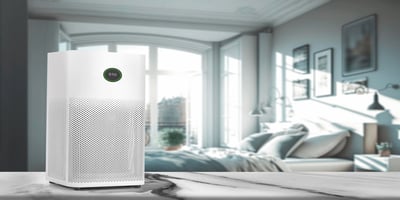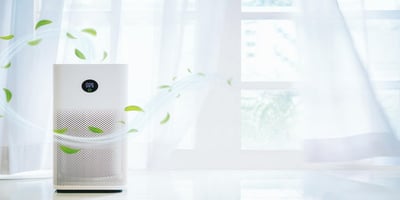5 Working Tips for Improving Indoor Air Quality in a Cold Season
Winter brings with itself cold weather and much more. It is a time of sealed windows and less outdoors, and in most cases, more heating on the heating systems. All of this amounts to poor indoor air quality. Indoor air pollutants build up pretty fast as there is less ventilation in the home environment. We present you with five workable tips to help you improve indoor air quality this winter.
Why Winter Affects Indoor Air Quality?
Winter brings cold temperatures, which means most of us keep our windows and doors closed to keep in warmth. Great for a warm house, this limits natural airflow, creating winter air quality issues. Lack of fresh air leads to a closed environment where dust, allergens, and other pollutants can build up.
Additionally, heating systems that are in such common use during winter will recirculate dust and indoor pollutants. These devices easily become sources of poor air quality; they can distribute allergens and other particles throughout the home-especially if their filters aren't regularly cleaned. Knowing what these challenges are will also facilitate taking the proper action for your home to be fresh and comfortable.
Tip 1: Increase Ventilation Safely
Proper ventilation means winter air quality mustn't deteriorate. But it is impractical for most people to open their windows in the middle of winter. Use other means of increasing ventilation without losing heat.
This can be effectively done by installing self-balancing heat recovery ventilators and trickle vents. An HRV installation may extract the stalest indoor air while replacing it with fresher outdoor air, having a minimum amount of heat loss. On the other hand, trickle ventilation allows controlled fresh air entry with a minimum amount of heat escaping your home. These methods ensure that your indoor environment is fresh without compromising on comfort.
Others include the installation of exhaust fans in the kitchen and bathroom. These fans extract moisture and pollutants produced in the kitchen and bathroom, and prevent their diffusion in your home. Running them, even for short periods of time will create a significant amount of improvement concerning indoor air quality.
.png?width=800&height=400&name=image_2024-10-25_20-38-24%20(1).png)
Tip 2: Utilize Air Purifiers
Another effective remedy for poor indoor air quality includes using an air purifier. The air purifiers clean the dust, allergens, and other particles from the air, leaving your indoors cleaner and healthier. Consider using a Sensibo purifier fitted with HEPA filters for better results. HEPA filters are designed to catch even the tiniest of particles, such as pollen, dust mites, and pet dander, so these should be ideal to provide better air quality in winter.
Place your air purifier in high-traffic rooms or places where you spend most of your time, for example, a living room or bedroom. That means you are going to breathe in the cleanest air, reducing the risks of respiratory problems and all other health issues.
In addition, you can complement this with an air purifier using activated carbon filters. Activated carbon filters are great at capturing odors, smoke, and VOCs from the air. This could, therefore, be a very good addition to your air purification strategy, especially during winter when homes are more sealed off.
Tip 3: Control Humidity Levels
Winter air is dry; it causes respiratory discomfort, skin dryness, and a build-up of dust. Maintaining appropriate levels of humidity in your home is very important to improve indoor air quality for comfort. You should maintain a level between 30% and 50%.
A humidifier will help you achieve the ideal humidity during the colder months. Properly humidified air in your home minimizes the spread of airborne pollutants and dust, making it easier to breathe. A good balance of moisture can reduce the chance of getting respiratory diseases, generally triggered by dry air.
But at the same time, you should also make sure not to over-humidize your home. High levels of humidity might result in mold growth and even worse deterioration of indoor air quality. Consider using a hygrometer to monitor the humidity levels in your home and then adjust your humidifier settings according to it.
You can also add some indoor plants along with a humidifier that help in maintaining humidity naturally. Indoor plants, including the peace lily and spider plant, in addition to adding moisture to the air, actually filter pollutants out of it and help keep a healthy indoor environment.
Tip 4: Clean Regularly
One of the easiest things to do to purify indoor air is to keep your living space clean. Regular cleaning goes a long distance in reducing dust and pet dander, among other pollutants. Use a vacuum cleaner fitted with a HEPA filter when vacuuming carpets, rugs, and upholstery to trap tiny particles that may circulate through the HVAC system..
Other ways to minimize the flying dust include dusting with a damp cloth instead of a dry one. Cleaning and disinfection can also be extended to frequently touched objects such as tables, counters, and doorknobs. Also, remember to clean or replace filters in your HVAC system to make sure it is not recirculating dust and contaminants throughout your home.
This would also include hidden areas that are normally never cleaned, like under the furniture, behind appliances, and corners. These are places that can harbor dust and allergens that disturb air quality. Washing bedding regularly, along with curtains and your pet's bed, can reduce the amount of allergens in your home.
This will also help reduce levels of pet dander, a very common indoor allergen. Keeping them off your furniture and out of your bedrooms further reduces the amount of pet allergens in your home.
.png?width=800&height=400&name=image_2024-10-25_20-37-50%20(1).png)
Tip 5: Use Natural Air Fresheners
Chemical air fresheners might be an easy way to give your house a good aroma, but the result leaves the air with chemicals like VOCs that simply worsen indoor air quality. Use a more organic approach that will definitely enhance the quality of air.
Consider replacing them with essential oils, which are a great alternative, possessing natural properties and the capability to freshen up your home without adding harmful chemicals. Citrus peels, baking soda, or even a simple bowl of vinegar can naturally absorb odors. These natural air fresheners are much safer and even better in maintaining indoor environment healthiness, especially during winter when ventilation is not adequate.
Another great idea is putting a pot of water on the stove to simmer, adding herbs and spices such as cinnamon sticks, cloves, or rosemary, which will fill your home with a nice, comforting fragrance and add that much-needed moisture to the dry winter air.
Other great options include using beeswax candles. While regular candles can produce toxic chemicals in the air, beeswax candles burn clean and can even help reduce pollutants in the air. They emit negative ions, which join with pollutants and help to carry them out of the air.
Stay Healthy This Winter: Your Air Quality Matters
Winter doesn't have to translate into poor indoor air quality in your home. Improve the air quality of your family's living space simply by taking a few basic steps: increase ventilation, use air purifiers, maintain the right humidity level, regular cleaning, and choose natural air fresheners. Remember, the air inside your house is just as important as the air outside, especially during periods when you spend more time indoors during colder months. Take these steps now to make for a fresher, healthier winter for you and yours.
Of course, maintaining indoor air quality is a little more work in winter. The benefits, though, pay off: better air quality, healthier, fewer allergy problems, and a much better living environment. Start following these tips and feel the difference they make in your home.


































.png)
.jpg?height=200&name=photo_2024-09-06_14-23-14%20(1).jpg)
.jpg?height=200&name=photo_2024-01-05_17-53-34%20(1).jpg)

